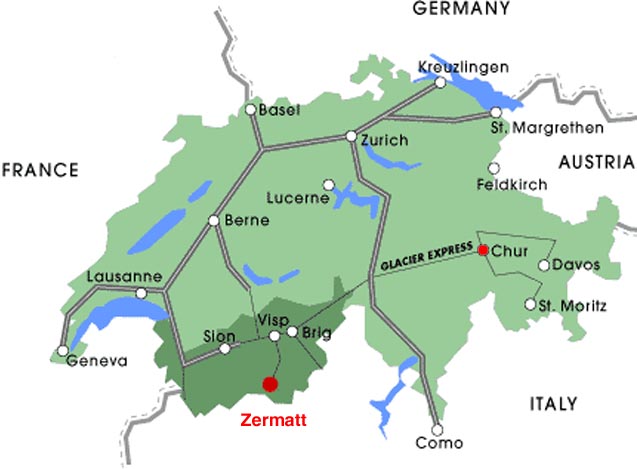 |
| On a Monday at half past ten in the morning, Irmi and I boarded a regional express in our small town of Thalwil, |
| outside of Zurich, and traveled to Chur. At the train station in Chur, we transferred to reserved first class seats |
| and settled in for the six-hour journey to Zermatt. A steward took our orders for lunch, and the train pulled out. |
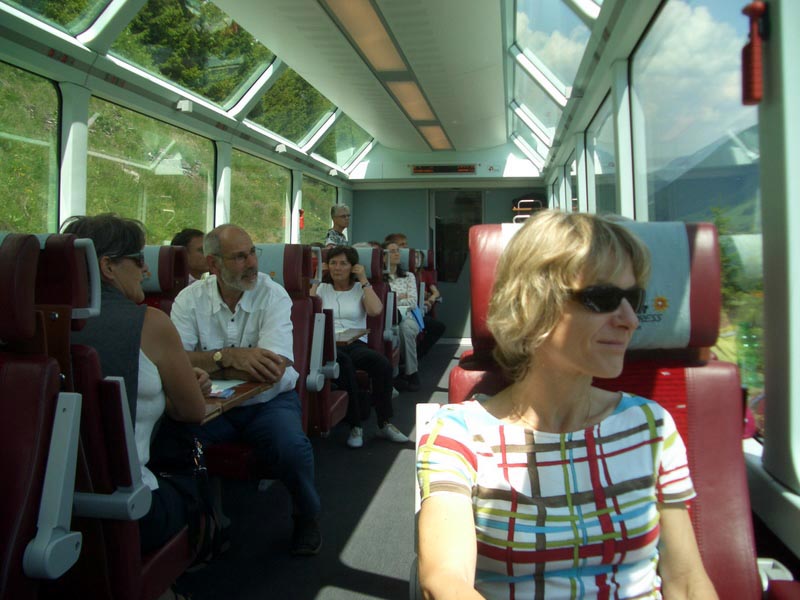 |
| Other trains might have wider and softer seats in first class, but this one was built with one thing in mind: |
| maximum views in all directions. The food and service, however, more than made up for austere seating. |
| By today's standards, we did not move at "express" speed; but back in 1930 this undoubtedly the fastest |
| route through the mountains. Today, the tracks are old and curve continuously, limiting speed almost to a |
| crawl; and, with a single track along most stretches, the train stops often, pulling onto sidings so oncoming |
| trains can pass. At first, I thought the locomotive was taking on water; but, duh, it was electric powered. |
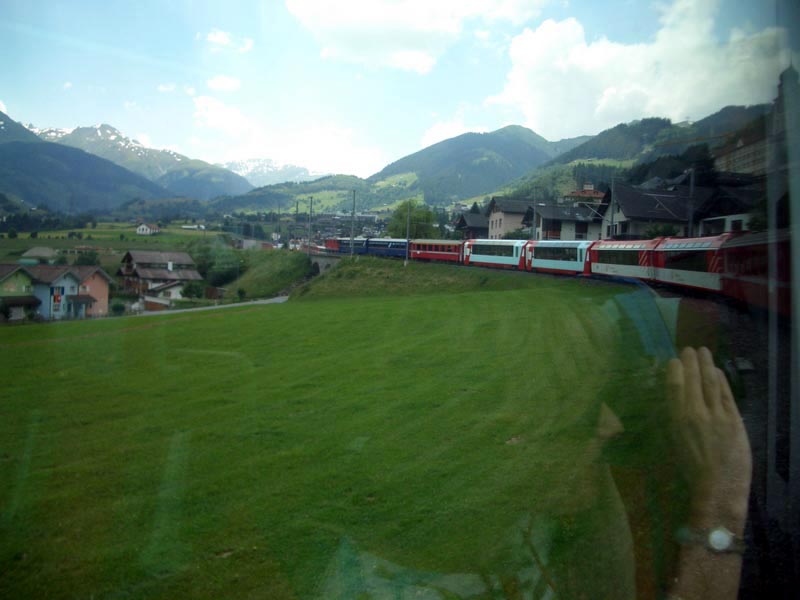 |
| In the early going, the train followed a wide flat valley floor. |
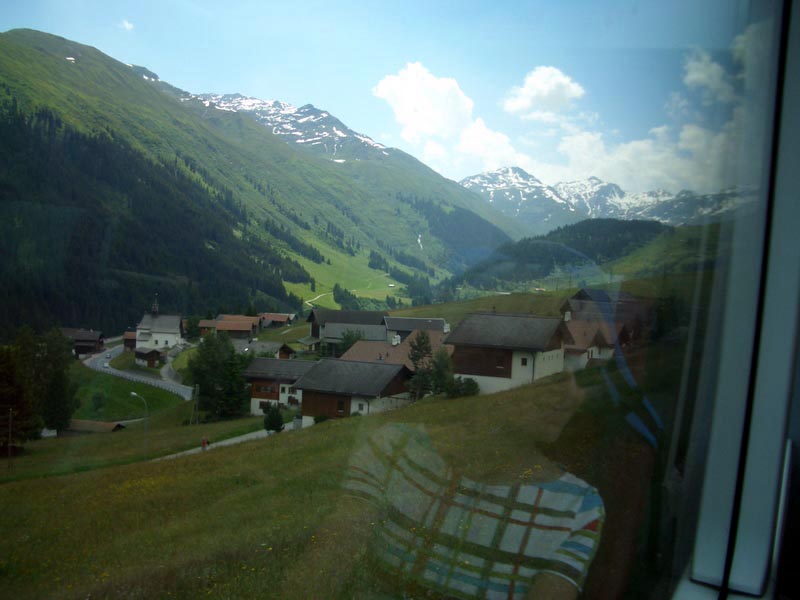 |
| Irmi's reflection in the glass is a nice touch by a superb photographer, don't you agree? |
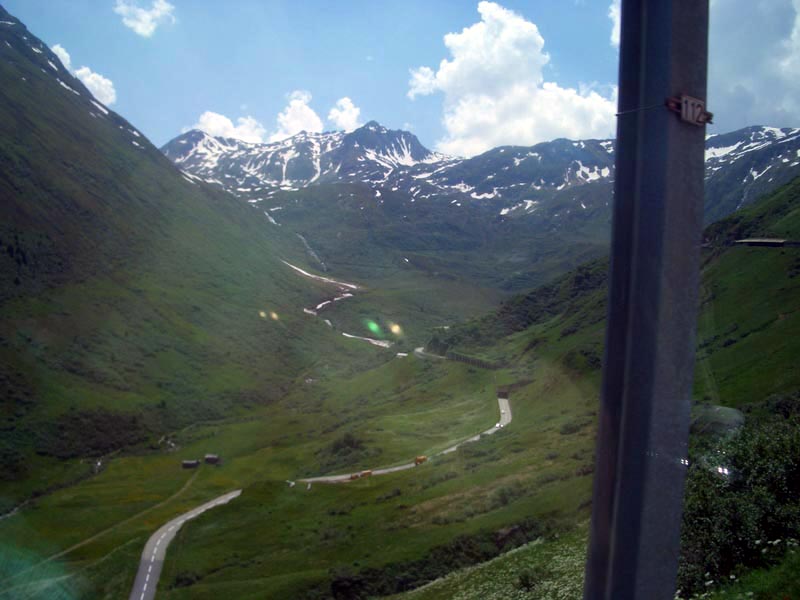 |
| Looking down upon peasants driving automobiles on a winding roadway. At the city of Disentis, we exited the train |
| for twenty minutes while a yard crew switched engines. From this point onward, the climb increased in grade up to |
| twelve degrees in places, necessitating a more powerful engine. The new one had a third (cog) wheel in the center |
| that engaged a matching notched track on the rail bed, providing a better grip. The landscape from Visp to Zermatt |
| turned from merely beautiful to truly spectacular, with magnificent views back down the valley as the train climbed. |
| Unfortunately, severe sun glare on the windows ruined every photo we tried to take on that stretch of the journey. |
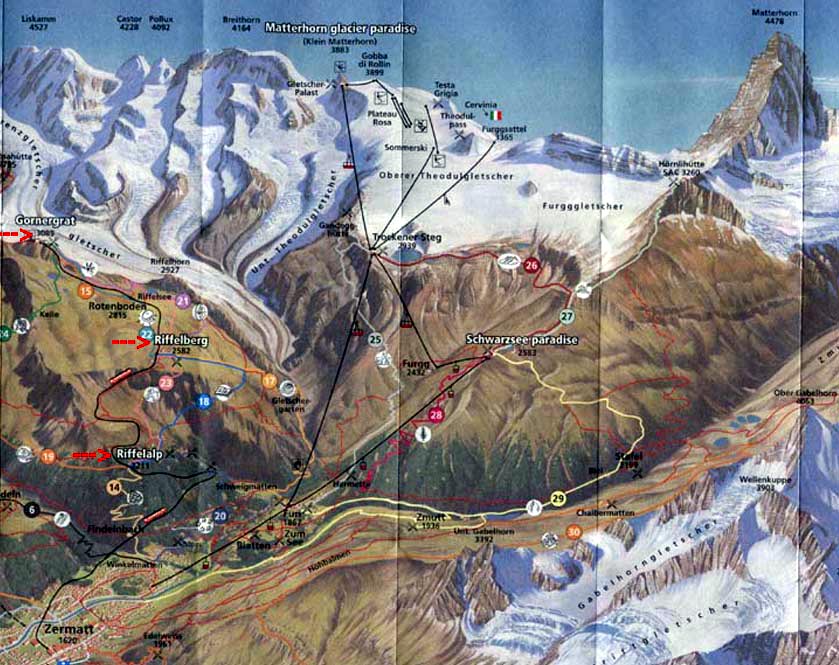 |
| We thoroughly enjoyed our ride on the Glacier Express; but, as it turned out, two days in Zermatt added an |
| unexpected element of adventure to the trip. In the map above, Zermatt (population 5,000) lies in a secluded |
| valley 1,620 meters (5,265 feet) above sea level. It is accessible only by rail; gasoline-powered automobiles |
| are strictly prohibited. Local transportation includes small electric powered taxi's, delivery trucks, and buses. |
| (The three red arrows on the left side of the map are points on a cog-wheel train route we took the next day). |
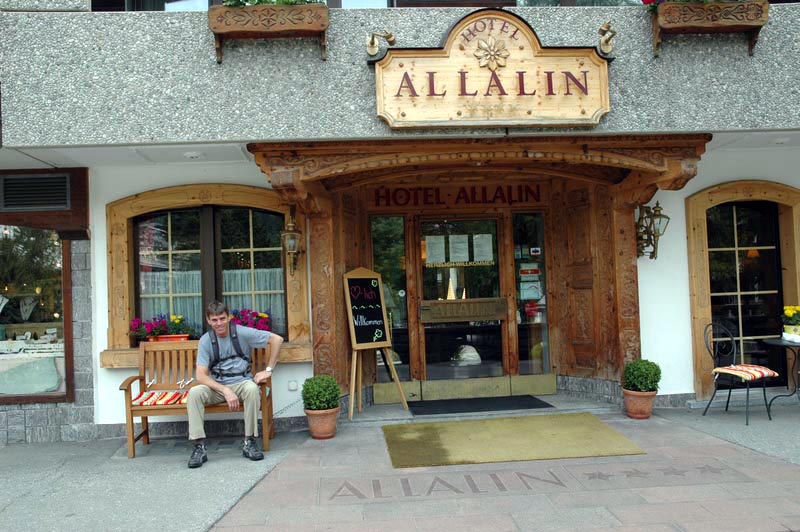 |
| Here we are, settled in our hotel (www.hotel-allalin.ch). That's Ron, after breakfast on Tuesday morning, |
| ready for our first hike into the surrounding hills. As in many European locations, this hotel looks deceivingly |
| small, but the friendly service and general helpfulness of the hotel staff would be difficult to beat anywhere. |
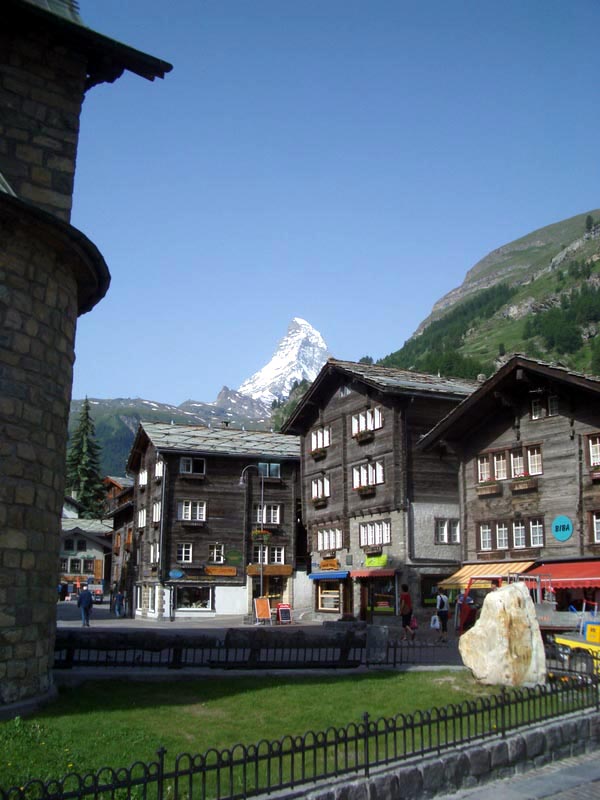 |
| Ron took this shot shortly after 10:00 a.m. on Tuesday morning, in the center of town, just a few steps from |
| our hotel entrance. That imposing peak in the background is the (real) Matterhorn (4,478 meters/14,553 feet). |
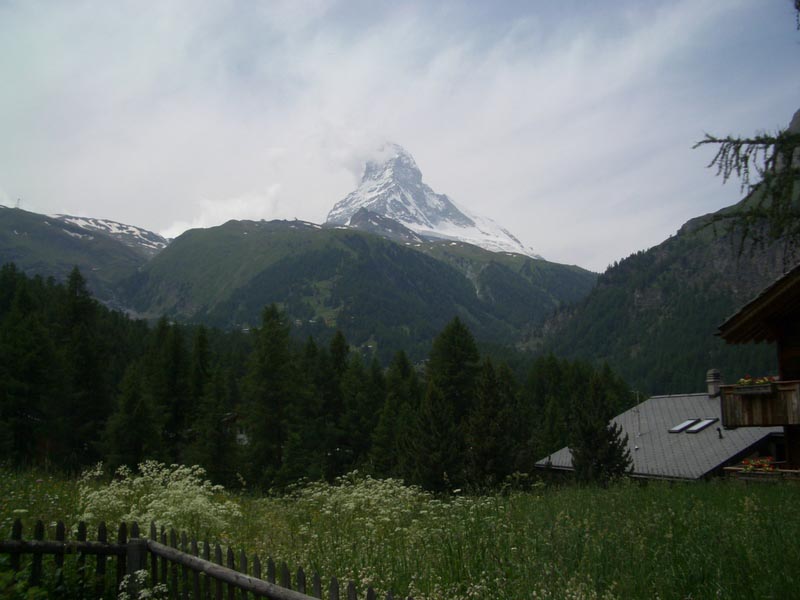 |
| We went shopping for a few hours Tuesday morning, and a sales lady recommended a hike off the beaten path |
| where few tourists ever venture, and we took her up on it, setting out around 2:00 p.m.. Our destination was the |
| "Goner Gorge." From the map above one can see that the Goner Summit (Gonergrat in German) is one of several |
| peaks towering above Zermatt. Even in late June, melting snow trickled into streams wending their way down the |
| mountain. At the Goner Gorge, we will see one such stream, now a raging torrent, pounding against granite walls |
| and over huge boulders. From a low-lying meadow above the city, the Matterhorn lies partially shrouded in clouds. |
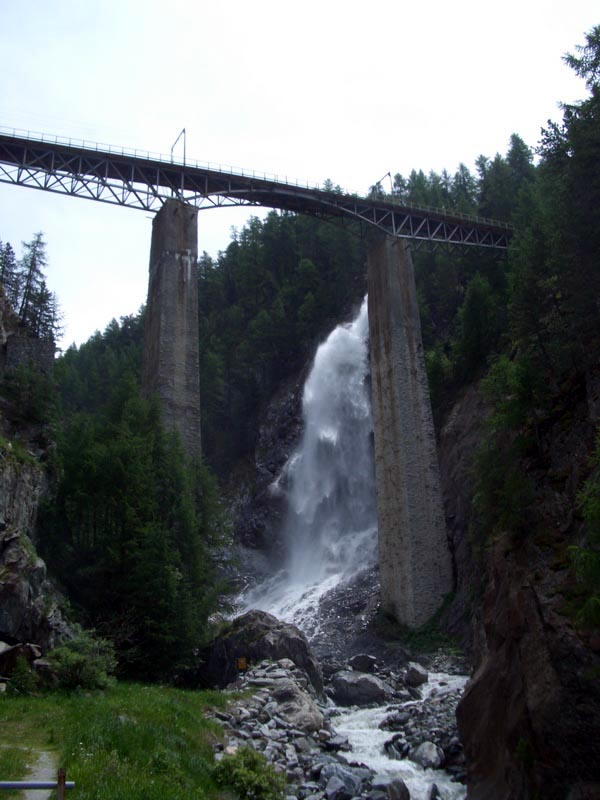 |
| At the edge of town, we encountered this tall train trestle and waterfall. The following day we |
| would pass over this bridge while riding the Goner Summit Train (part of the Matterhorn Railway). |
 |
| Naturally, we became lost. The sales lady's instructions seemed simple enough, but we soon found |
| ourselves climbing a paved road which could not be correct, because, well, water flows downhill, and |
| the gorge was supposed to be located not far from the edge of town. Then we saw this path and |
| decided to take a chance. Regardless of where it went, it had to be more interesting than the road. |
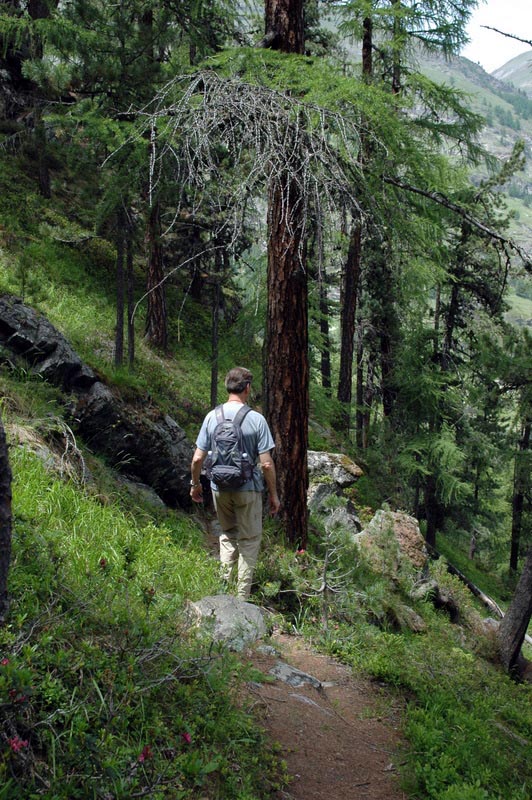 |
| At first, the woods seemed fascinating, so lush and green that we half-expected a leprechaun to |
| leap from behind a bush at any moment; but the trail soon turned treacherous, infested with roots |
| and clinging perilously to steep hillsides with guide ropes in many places. Normally, low-top hiking |
| shoes sufficed; but this path called for sturdier footwear, like perhaps some leather Alpine boots? |
| Sorry, no photos from the dangerous sections, as we were too busy concentrating on our footing. |
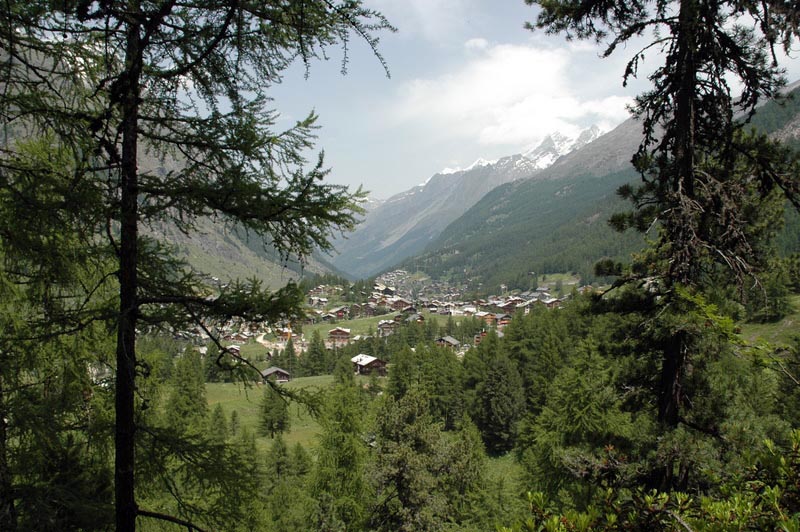 |
| In spots, we were able to peek through the trees back down the mountain toward Zermatt. |
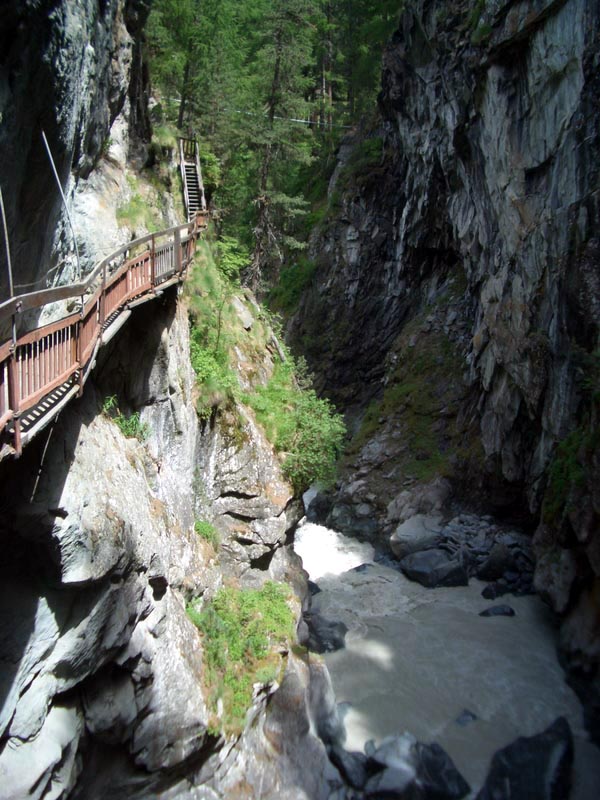 |
| Miraculously, the path we stumbled upon eventually led us to the Goner Gorge. The khaki colored |
| water attests to the amount of silt carried downstream. Deep within the gorge, constant pounding |
| of river against rock raises a fine mist that settles on the stone walls high above and slowly dries |
| under direct sunlight. Walking the length of this wooden bridge, I traced a fingertip along the wall, |
| and a fine coat of light brown powder adhered to my skin. Was I breathing that stuff in my lungs? |
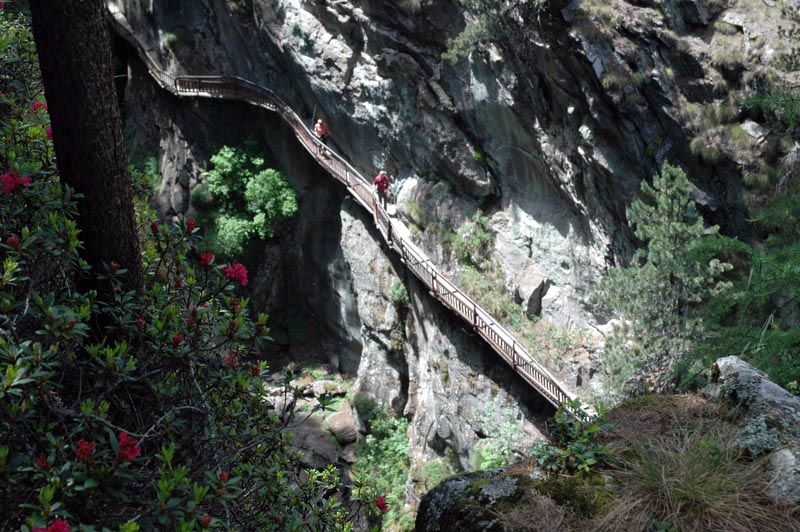 |
| This perspective provides a glimpse into the depth and grandeur of the gorge. Irmi marveled at the |
| daring and skill of the men who built the walkway. Indeed, someone had to be the first to travel this |
| route. Even today, with the convenience of a prepared path, it is not a place for the faint of heart. |
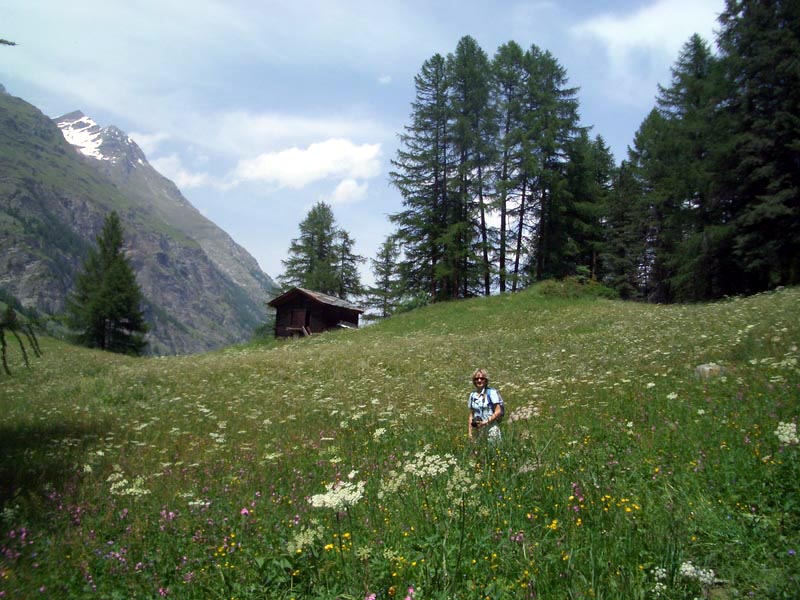 |
| Having, with luck, achieved our goal of visiting the Goner Gorge, we headed back down |
| the mountain . . . and discovered this beautiful meadow. Beyond the small building in the |
| background, a smooth easy path down a long gentle slope led to the Zermatt city center. |
| We arrived back in Zermatt in time to shop for another two hours before the stores closed at six p.m. At the hotel, |
| we freshened up and shared a quiet dinner in a cozy corner of a small rustic restaurant in the "Old Zermatt" section |
| of town. Following that, we strolled around the city for an hour and a half. It remains light until well past 9:30 at this |
| time of year, so Irmi led the way up a steep road to a spot with a commanding view of the city, and we watched the |
| sun sink quickly behind the mountains. Soon, the moon appeared, and, well, we began smooching. Hand-in-hand, |
| we strolled slowly back to the hotel and collapsed in bed, pulling the feather "Bettdecke" up to our chins, and slept. |
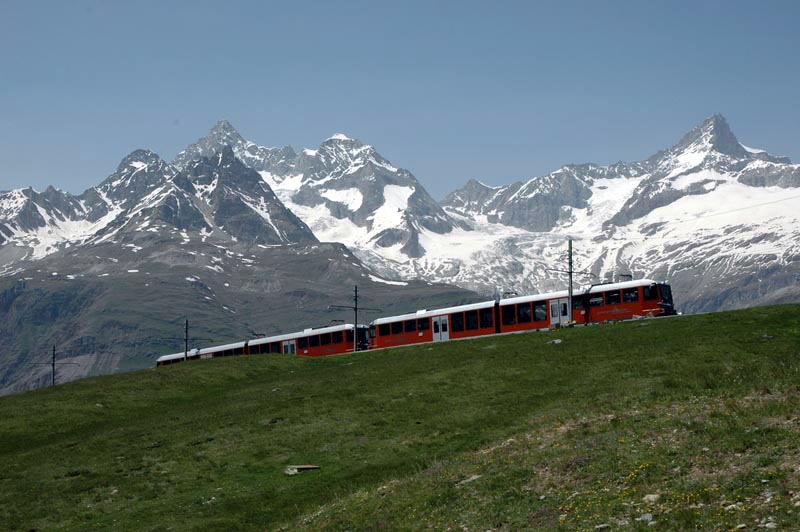 |
| Wednesday morning, after a leisure breakfast, we rode this cog-wheel train up to the Goner Summit. |
| From the valley floor, at 1,620 meters ( 5,265 feet), the train climbs to an elevation of 3,089 meters |
| (10,039 feet), an increase of 1,469 meters (4,774 feet), bringing us to a point far above the tree line. |
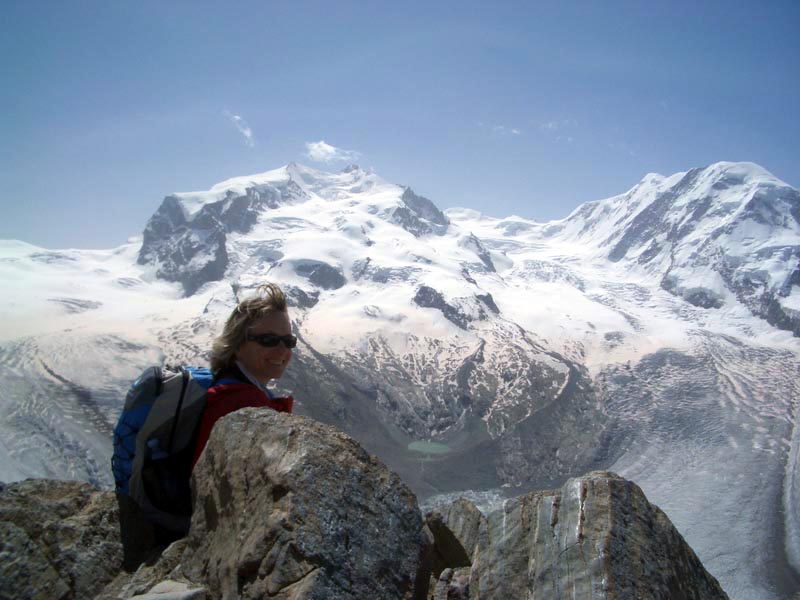 |
| Irmi, sitting on a pile of rocks above the top gondola station and restaurant, about as high as a tourist can get on |
| the Goner Summit. In the background, the Goner Glacier (left) is joined by the Grenz Glacier (right). Below this |
| point, the combined glacier is called the Goner. Down on the valley floor, the temperature had been 29 degrees |
| Celsius (85 Fahrenheit); up at the top, it was dramatically cooler at 11 Celsius (52 Fahrenheit) with strong winds; |
| a refreshing change, to be sure, but definitely requiring Gortex jackets for the hour or so that we spent at the top. |
 |
| Another view of the Goner and Grenz glaciers from atop the Goner Summit. |
| (That small lake is reflected on a commercial map, so it must be a permanent fixture.) |
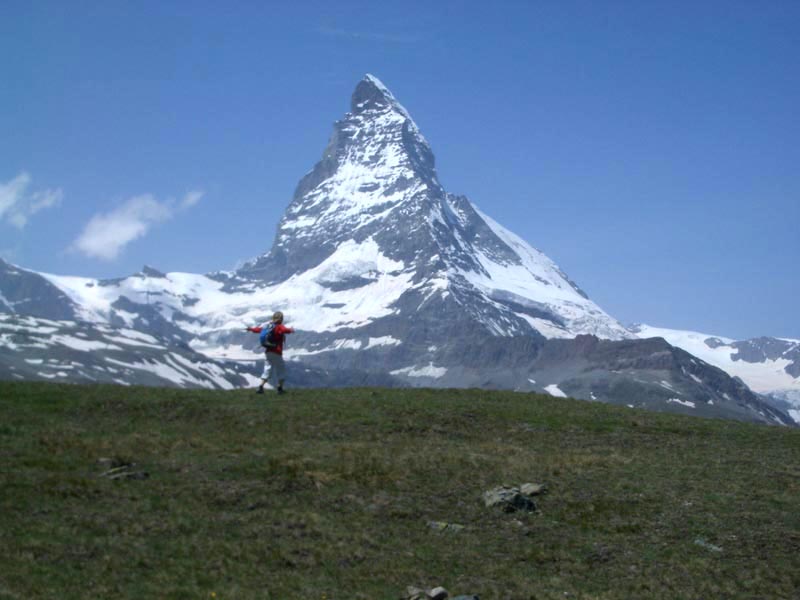 |
| At the summit, we re-boarded the cog-wheel train and rode it back down to the Riffelsberg station |
| (2,582 meters/8,391 feet) where we disembarked for a planned hike along marked trails leading |
| first to "Glacier Garden," then on to Riffelalp (2,211 meters/7,186 feet). Riffelsberg and Riffelalp |
| are both marked on the previous map (above) with red arrows. At Riffelalp, we would once again |
| board the cog-wheel train and ride it back down to Zermatt. Yes, that is the Matterhorn, again. |
| Every time we turned around, there it was. Irmi would like to bring her yoga group to this meadow. |
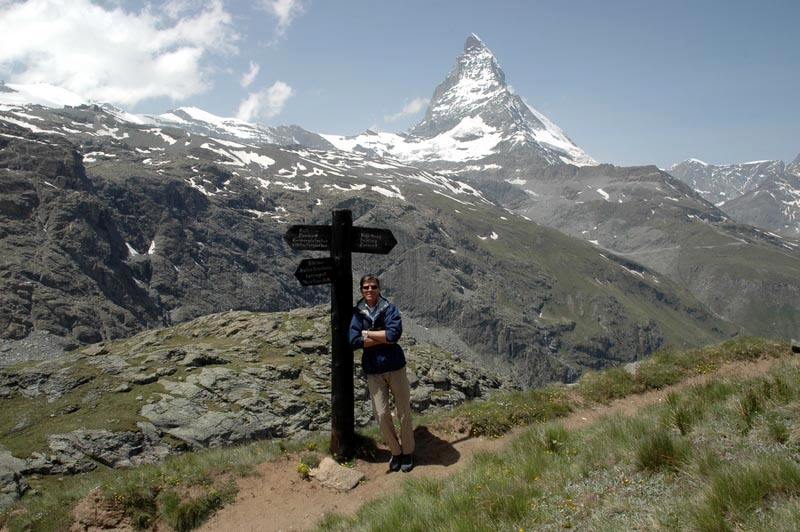 |
| Ron, looking lost, waiting for a policeman to happen along and give him directions. |
| In spite of this sign post, trails were not well marked. One required a good map! |
 |
|
Irmi takes a short break beside the trail, eating an apple, contemplating the magnificence of old Mother Matterhorn. |
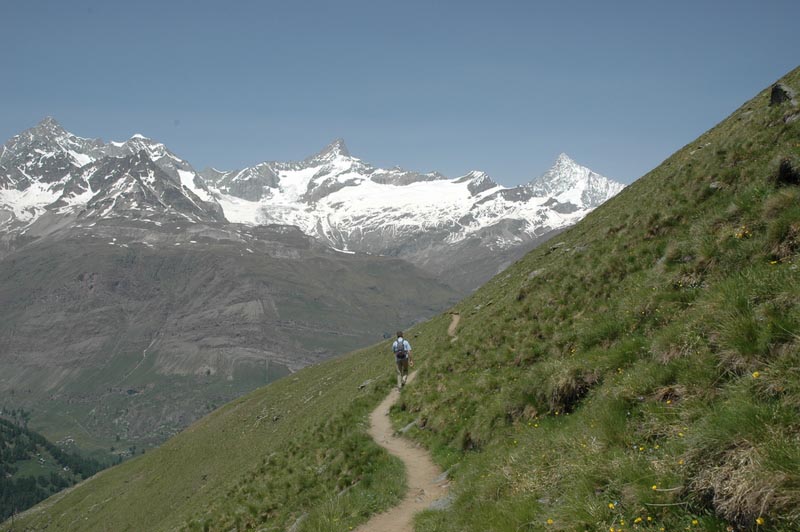 |
| Ron forges ahead, unaware that Irmi has stopped (yet again) to photograph flowers. |
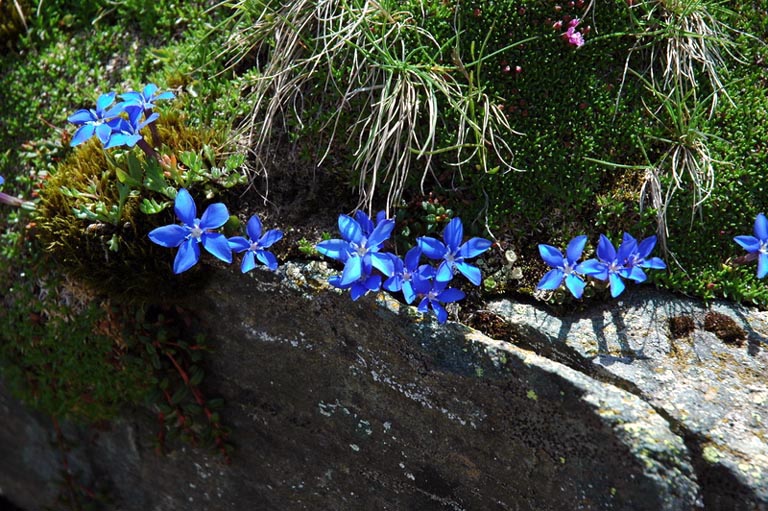 |
|
Such widely varying and delicate beauty existing so far above the tree line absolutely boggles the mind. |
 |
| Having descended below the tree line once again, we now follow blue trail number 18 (see map above), clearly |
| marked as "Mark Twain Weg," causing me to wonder if Twain might have trekked this way during one of his visits |
| to Europe, perhaps while chronicling observations for his celebrated book, "The Innocents Abroad." Just beyond |
| the bend ahead, the trail became quite steep and rocky, and we lost our way again, due to a lack of signs, and |
| were forced to walk parallel to a railroad bed for half a kilometer before finally arriving at the Riffelalp station. |
| We arrived back in Zermatt around three in the afternoon and called our hotel from the train station. Twenty minutes |
| later, a bell hop arrived in a small electric van with our suitcases (as well as a large shopping bag filled to capacity), |
| and we boarded a train for Visp. Little more than an hour later, we arrived in Visp and transferred to a train headed |
| for Bern. In Bern, we boarded a direct express for Zurich, arriving home in Thalwil shortly before 8:00 that evening. |